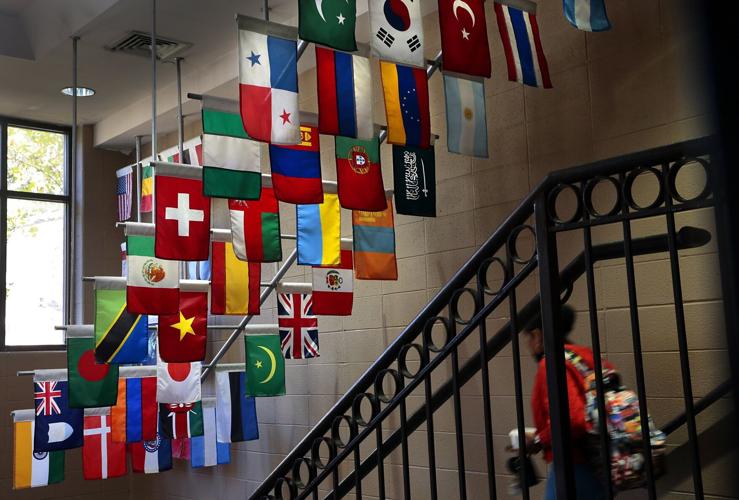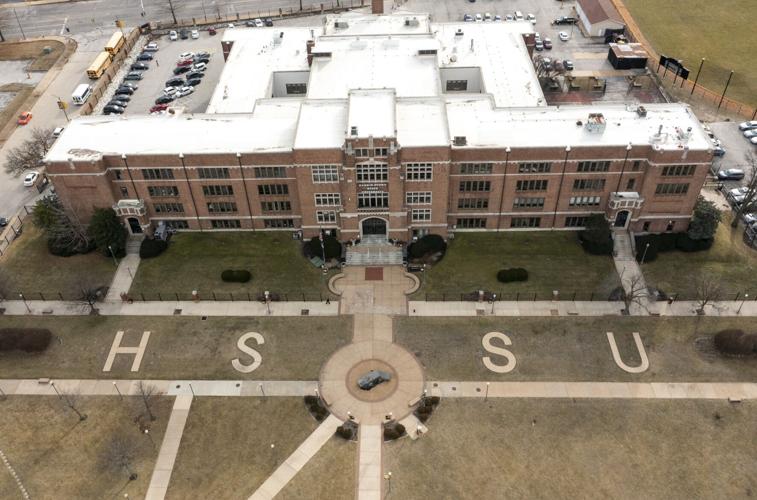
World flags decorate the staircase of the student center on the campus of Fontbonne University on Thursday, Nov. 4, 2021. That fall, during the COVID pandemic, the university saw a dip in freshmen enrollment, along with travel restrictions resulting in fewer visas for international students.
CLAYTON — The upcoming closure of Fontbonne University has aspiring college students and their families asking: Who will be next?
The private Catholic institution will shut down in 2025 after losing more than $14 million in revenue and 60% of students over the past decade. Higher education analysts have long warned of the challenges looming for colleges like Fontbonne, where enrollment dropped to 650 undergraduates this year.
Across the state, the number of students in two- or four-year colleges has dropped by 10% since 2018.
“There has always been a perception, and I think it is reality, that Missouri has more universities than it needs,” said Dudley McCarter, Clayton attorney and member of the . “The next three or four years is going to be a real shakeout.”
People are also reading…
Birth rates have steadily declined since the Great Recession in 2008, a cohort that will start graduating high school next year. At the same time, tuition and operating costs have skyrocketed. And with rising doubts among Americans about the value of higher education, more campus closures are “inevitable and probably necessary,” McCarter said.
Nationwide, undergraduate enrollment increased slightly this year to 15.3 million but is still down nearly 1 million students from fall 2019, according to the . And colleges that were already struggling before the pandemic are now running out of federal relief funds.
Fontbonne joins a growing list of private liberal arts colleges that have collapsed under financial pressures in recent years, including and in Illinois.
The released a in March of 37 Midwestern colleges in danger of closing due to “significant financial distress” in the past five years.
The at-risk campuses include Maryville, Missouri Baptist and William Woods universities. Schools in the region listed as especially perilous are Harris-Stowe, McKendree (Illinois), Quincy (Illinois), Webster and Fontbonne, which announced its closure after the list was released in March.
Several universities on the watchlist, like Maryville, Missouri Baptist, Quincy or Webster, are designated by Fontbonne as “teach-out” partners, which generally means students can automatically enroll in the schools at the same cost and with the same amount of credits.
Most Fontbonne students “are not eager to potentially go down that road again,” said Teresa Steinkamp, director of advising at the Scholarship Foundation.
College closures often derail graduation. Fewer than half of students successfully transfer to another college, according to the . Taxpayers can be left with the tab for unpaid federal student loans.
Aside from the financial risks, there are personal consequences of attending a college on the watchlist, Steinkamp said.
“I think there’s a really big emotional, psychic cost to students,” she said. “They’ve invested not just their time and money but parts of themselves and their passions and values. To have that rug pulled out from underneath them can be really damaging.”
Here are the financial statistics for many of the smallest schools in the broader �����Ӱ�ԭ�� region:
Hannibal-LaGrange University in Hannibal dropped below 400 students in fall of 2022, down from 730 in 2018. The university did not submit enrollment figures this year to the Missouri Department of Higher Education and Workforce Development. The Christian school is on probation with the accrediting body in part because of a “long-standing culture of complacency with unbalanced budgets and operating deficits.”
Like other small colleges, Hannibal-LaGrange has borrowed from its endowment to pay the bills. The university had borrowed 75% of its $8.8 million endowment as of June 2021, according to the commission.
Investigators with the Higher Learning Commission visited the campus in April and will release an update this fall on the school’s accreditation status. A loss of accreditation is an effective death sentence for colleges.
On its website, Hannibal-LaGrange states, “We are confident that the plans we have made will be successful in strengthening our institution. Probation can be a very positive event in the life of an institution.”

The campus of Harris-Stowe State University in �����Ӱ�ԭ�� on Thursday, Feb. 1, 2024.
Harris-Stowe State University in �����Ӱ�ԭ�� will also receive an accreditation update this fall after being placed “on notice” by the Higher Learning Commission in 2022. Enrollment has fallen by nearly 40% in six years — down to 964 full-time students this year from 1,523 students in fall of 2018. Harris-Stowe’s graduation rate of 10% in four years is among the lowest in the country.
Everyone who applies to the historically Black university is admitted. Harris-Stowe is a public institution, so its future may be more certain because of ongoing state support, said McCarter, the higher education board member.
The university’s long history as the dominant training ground for �����Ӱ�ԭ�� teachers has also collapsed in recent years. Harris-Stowe is no longer accredited by the main oversight group for teacher training programs, the .
Seven students graduated from Harris-Stowe’s teacher training program in spring of 2023, according to the university.

The campus of Lindenwood University in St. Charles on Thursday, May 9, 2024.
Lindenwood University in St. Charles has been struggling to recover since COVID-19 when its enrollment fell 20% to around 7,500 students in the first year of the pandemic. It mirrors a decadelong trend of declining enrollment in which it fell 39%. School officials attributed the decline to the closure of its Belleville campus and the phasing out of satellite locations.
The university late last year announced it would eliminate 10 athletic programs, a move that will affect 280 students. Officials have said it was part of its “rebalancing” to match the number of sports its peers in the Ohio Valley Conference offer.
Lindenwood said it is focusing on online programs and nontraditional students, a move that officials said is working given its recent enrollment climb. It has a “test-optional” admissions policy that allows prospective students to apply without submitting their ACT or SAT test scores.
Its endowment, which supports research, professorships and scholarships, grew 23% to over $200 million in the 2022-2023 school year suggesting it is improving its financial prowess, according to the latest available financial data.
The university is one of the approved “teach-out” schools accepting Fontbonne students.

The campus of Maryville University is seen in Town and Country on Thursday, May 9, 2024.
In Town & Country, Maryville University boasted more than 10,000 students in the fall of 2023, a roughly 9% increase from the year before when enrollment fell to its lowest since fall 2018. More than half of the undergraduates and 86% of graduate students take their courses online, according to the .
But it’s unclear if its revenue has seen a similar rebound. The private institution reported a nearly 10% decline in revenue to $114 million in the 2021-2022 school year from the prior year, the latest financial data shows.
It was the second consecutive year that revenue had fallen at Maryville. University officials have said the dip was due to the pandemic and that Maryville has rebounded since. The school is projecting revenue for the current school year to grow to $131 million.
Meanwhile, its leader, President Mark Lombardi, reported $1.7 million in total compensation, the highest of any university leader in the �����Ӱ�ԭ�� region, records show.
McKendree University in Lebanon, Illinois, has 1,613 students this year, down from 2,342 in 2015. The school with ties to the United Methodist church had an operating deficit of more than $860,000 in 2022, federal tax records show. An audit the same year by accounting firm CLA found several significant deficiencies in McKendree’s finances and administration.
The audit cites staff turnover and changes for financial concerns that “increases the risk of misstatements, fraud, or errors.”
Missouri Baptist University in Creve Coeur has steadily grown its enrollment from the losses it experienced during the pandemic. The private Christian college experienced an 8% loss in enrollment in fall 2020 to a little over 4,800 students. This past fall, enrollment stood at 5,600 with a boost in online and graduate enrollment. Only 2,875 of the total are full-time undergraduates, according to state data.
Missouri Baptist has a test-optional admissions policy that allows interested students not to submit test scores as part of their applications. The minimum GPA for freshmen students is 2.5 and 2.0 for transfer students, according to its website.
While the university has managed to avoid slipping into the red, it did acknowledge in a recent audit that 11% and 20% of all contributions were received from one donor, the Missouri Baptist Convention, in 2022 (where it reported $36 million in revenue) and 2021 ($45 million in revenue), respectively.

The concrete trusses in Anderson Hall are part of architect Bernard R. Maybeck's notable interiors on the Principia College campus in Elsah, Ill., seen Feb. 1, 2018.
Principia College in Elsah, Illinois, has hovered between 300 and 350 students for the last few years, down from 464 a decade ago. About 40% of students are non-U.S. residents, who typically pay full tuition. The school has placed a “temporary moratorium” on several majors because of a lack of students: Art History, Chemistry, Dual Languages, Engineering, Environmental Studies, French, Physics, Sociology/Anthropology and Spanish.
But the Christian Science college shows no signs of financial distress — the Principia Corporation, which also runs Principia School in Town and Country for kindergarten through high school, had $257 million in revenue and $1.1 billion in total assets in 2022, according to federal tax records.
Quincy University in Quincy, Illinois, is one of the approved “teach-out” schools accepting Fontbonne students. Quincy is students with a promise of a similar culture — small, private, Catholic and close to the Mississippi River.
But the problems that led to Fontbonne’s closure also plague Quincy, namely a declining number of students (1,113) and higher debt ($36 million) than endowment ($21.5 million as of 2022).
In 2022, Quincy was considered “not financially responsible” on a scale of eligibility for federal financial aid programs. The university has three years to increase cash flow or risk losing eligibility, according to an audit from Illinois accounting firm Gray Hunter Stenn. Last year, Quincy had an operating deficit of $2.5 million.
Webster University officials say the private college is making great strides in turning around its years of falling enrollment and revenue. Webster has lost more than $160 million, including a $37 million deficit at the end of the 2022-23 school year. Its financial issues prompted university leaders to petition the court to allow it to tap into its roughly $30 million endowment to allow Webster to meet a loan obligation, a strategy Fontbonne University also utilized.
Enrollment had followed a similar path, tanking 50% to around 10,000 students compared to a decade ago. But the university reported its highest enrollment since 2017 in fall 2023 at more than 13,000 students thanks to international recruiting and what the school said was its focus on science, technology, engineering and mathematics programs. Its student body, though, is still about a third lower than it was a decade ago.
William Woods University in Fulton had an operating deficit of $6 million in fiscal 2023. Enrollment at the Christian school has grown 20% in the last year to 1,150, but still down from 1,450 five years ago.

The Webster University Gorlok mascot statue, a bronze by Mitch Horstmann, watches over students from the entrance to Sverdrup Hall in Webster Groves on Tuesday, May 7, 2024.
You could spend your time trying to explain how to do these 10 things over the phone — or you could do it now, before your kids head out on their own.


























